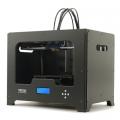Results 21 to 28 of 28
Thread: Living Hinge Design GUide
-
06-16-2016, 10:56 AM #21
nope - use the right material and the lifespan will be easily as good as injection moulded :-)
Given the way you can use very thin layers to form an actual flexible matrix that resists tearing in all directions, I suspect you could probably improve on injection moulded hinges.
There are some seriously amazing materials out there in 3d printer land.
Like I said, get your printer, try some of the more exotic filaments and then come back to me.
3d printed stuff can be way better than you seem to think it is :-)
-
06-16-2016, 11:20 AM #22
-
06-16-2016, 11:22 AM #23
Can't wait till he gets his printer :-)
That first lightbulb moment is brilliant.
-
06-16-2016, 05:27 PM #24Engineer-in-Training

- Join Date
- May 2016
- Location
- SE Wisconsin
- Posts
- 206
You keep saying "use the right material".
That doesn't work if the material you need is not conducive to a living hinge. We use 3d printed prototypes in my industry often. There's one sitting on my desk right now. Of course this one is just a large handle though.
If I need something that very specifically does NOT flex under load, then printing a living hinge with it would not work very well, would it?
Nylon is a great example of this, yet we can mold nylon living hinges without significant issue.
-
07-07-2016, 02:40 AM #25
In my experience, workable living hinges can be made through FFF/FDM 3D printing. However, they will not nearly be half as strong and durable as IM'ed hinges due to the filament structure, material and heterogeneities. The best idea to me seems to use a dual extruder and print the hinge in a flexible material, with an uneven number of layers - 3 or higher - the outer layers being aligned with the bending direction.
-
07-07-2016, 04:26 AM #26
Sorry CA but I'm with AFM on this. A living hinge requires specific conditions that can only be achieved when specific melt and flow criteria are being met. 3D printing cannot do this. You might get several flexions off a printed item but not the ridiculously high number as you would off an injection moulded item. 3D printed living hinges are for functional testing only.
-
07-07-2016, 04:52 AM #27
I guess I'm just going to have to prove this :-)
And I presume you're totally disallowing flexible filaments ?
Given that polyflex will print stiff parts as well as totally flexible parts and is damn near indestructible. Printed some 0.4mm sheet a while back - could not tear it.
That's proved the point right there.
But there are other materials that will also do the job.Last edited by curious aardvark; 07-07-2016 at 05:26 AM.
-
07-20-2016, 02:27 AM #28
I have made some living hinges with Biome3D filament which is more flexible, and they work fine for hundreds of bends.
So not the amount you get with injection molding, but still nice enough to be useful for many things and if it breaks you simply reprint it. It opens up a lot of possibilities.
The standard swatches I print to show my clients the range of filaments I offer all include a living hinge. Flexible materials are best for this, woodfill is worst..
I am very interested to see the polyflex hinge.





 Reply With Quote
Reply With Quote











AI generated 3d models -...
04-12-2024, 11:54 AM in 3D Modeling, Design, Scanners